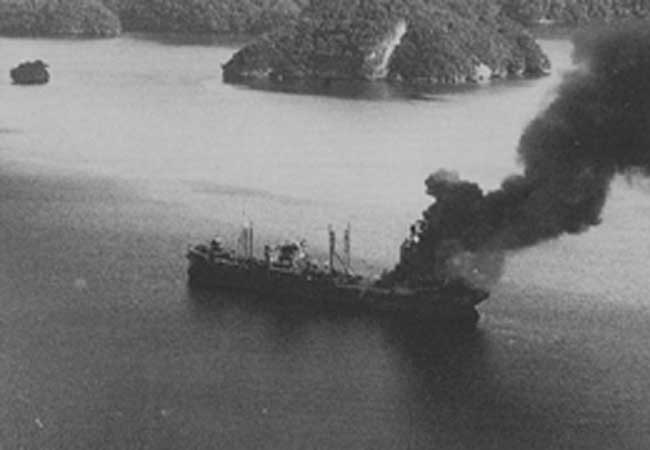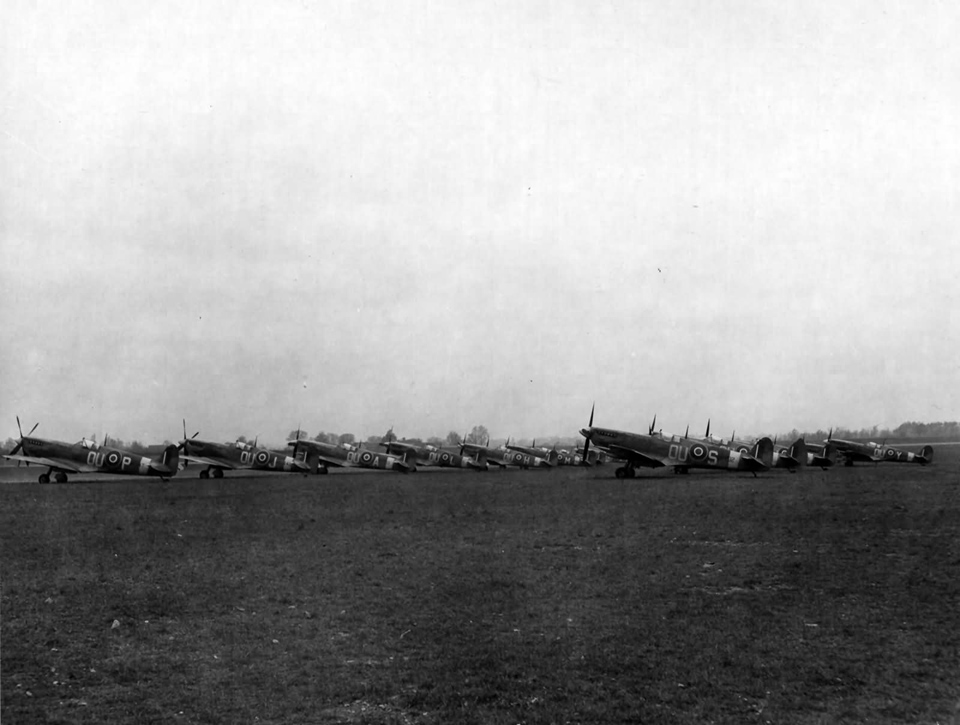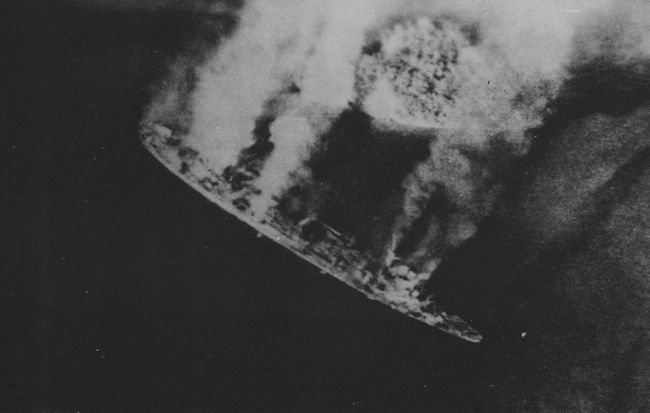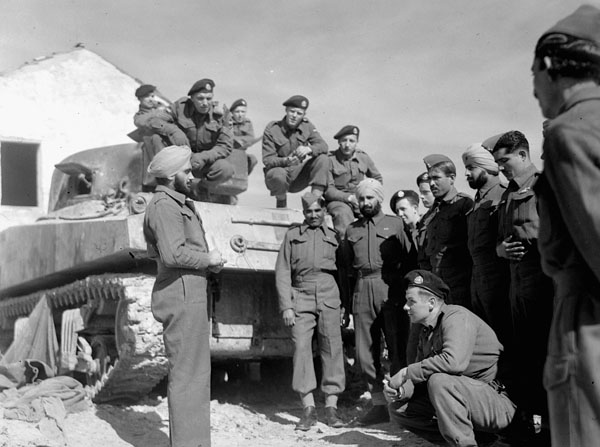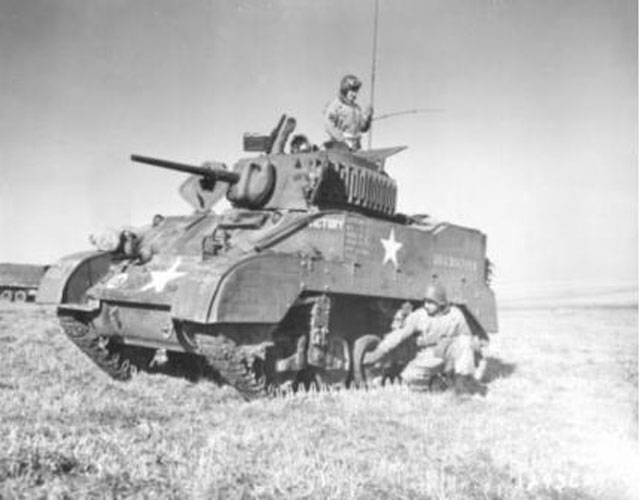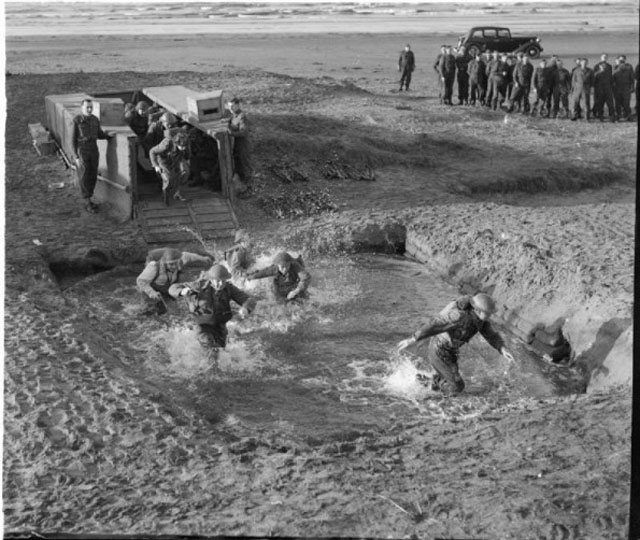Admiralty Islands
While mopping up operations continue on Manus and Los Negros, operations against the adjacent islands begin. After a preliminary bombardment the 1st Squadrona of the US 7th Cavalry occupies Pityilu Island three miles north of Lugos Mission. There is almost no opposition.
[Air Operations, Carolines
- VII Bomber Command B-24s mount a pre-dawn attack against an airfield in the Truk Atoll. Despite bad weather, 11 of 19 5th Heavy Bomb Group B-24s sent attack Moen Island in the Truk Atoll. 3 5th Group B-24s are lost.
- Beginning with a fighter sweep before dawn, US carrier aircraft from Task Force 58 and Task Group 50.15 open a three-day offensive against Japanese bases in the western Carolines, especially Angaur and Peleliu islands in the Palau Islands. The attack is in support of the upcoming invasion of Hollandia, New Guinea—to interdict air routes to New Guinea. In addition to the leveling of many land targets by carrier bombers, 8 of the carrier TBMs sink a Japanese destroyer and several smaller naval vessels, three fleet oilers, and at least 20 other ships with bombs and torpedoes.
- During the Palau attacks, TBMs from VT-2, VT-8, and VT-16 sow aerial mines in Palau Harbor from the air, the first operation of its kind conducted by carrier-based bombers.
- VF-5, VF-8, VF-10, VF-23, and VF-30 F6Fs (and the crews of a VT-2 TBM and a VB-8 SBD) down 26 Japanese fighters and a G4M 'Betty' bomber over the Palau Islands between 0715 and 0845 hours. A VF-16 F6F downs an A6M Zero over Peleliu Island at 0930 hours. A VF-10 F6F downs an E8N 'Pete' reconnaissance seaplane over Babelthaup Island at 1216 hours. VB-2 SBD crew downs a G4M 'Betty' bomber over the airfield on Peleliu at 1430 hours. A VF-5 F6F downs an A6M Zero over Peleliu at 1700 hours. A VF-10 F6F downs a Ki-27 'Nate' fighter near Peleliu at 1743 hours. VF-31 F6Fs down 9 D4Y 'Judy' dive bombers at sea 50 miles from Task Force 58 at 1910 hours. A VF-8 F6F downs a G4M 'Betty' bomber at sea 40 miles from Task Force 58 at 1935 hours.
- During the night of, 21 11th Heavy Bomb Group B-24s attack the Truk Atoll, and 868th Heavy Bomb Group SB-24s heckle the atoll.
Air Operations, CBI
BURMA- 17 10th Air Force A-31s attack the Kaing and Paungbyin areas. 5 A-31s attack targets of opportunity around Thayaung. 6 P-51s attack the airfield at Anisakan.
Air Operations, Europe
RAF BOMBER COMMANDEvening Ops:
- 795 aircraft are sent to Nuremberg. Included in this total are 572 Lancasters, 214 Halifaxes and 9 Mosquitos.
- Nuremberg is a city deep in southern Germany with a heavily defended air space. Everything goes wrong. The route to the target is clear, no clouds to protect the bombers. The Germans carry out a near perfect Tame Boar operation. All the diversions the RAF puts up are ignored. The growing technical skill of the German night-fighter controllers and the new Lichtenstein airborne radar sets combine with German ability to track the RAF H2S and IFF transmissions in inflicting unacceptable punishment on the attacking force. The first fighters appear before the bombers reach the Belgian border and a fierce battle in the moonlight lasts for the next hour. 59 bombers are shot down in just one hour on the main long leg of the approach route. The target itself is covered with cloud and few bombers actually bomb the city. The air combat action is much reduced on the return flight when most of the fighter have to land.
- Most of the returning crews report that they had bombed Nuremberg but subsequent research shows that approximately 120 aircraft had bombed Schweinfurt, 50 miles north-west of Nuremberg. This mistake is a result of badly forecast winds causing navigational difficulties. 2 Pathfinder aircraft actually drop markers at Schweinfurt. Much of the bombing in the Schweinfurt area falls outside the town and only 2 people are killed in that area. The main raid at Nuremberg is a failure. The city is covered by thick cloud and a fierce cross-wind which developed on the final approach to the target causes many of the Pathfinder aircraft to mark too far to the east. A 10-mile-long creepback also develops into the countryside north of Nuremberg. Both Pathfinders and Main Force aircraft are under heavy fighter attack throughout the raid. Little damage is caused in Nuremberg.
- 64 Lancasters and 31 Halifaxes are lost in which 545 aircrew are killed, the biggest Bomber Command loss of the war. It is estimated that night fighters shoot down 79 aircraft. As a result long range area raids are suspended.
- 49 Halifaxes lay mines in the Heligoland area, 13 Mosquitos are sent to night-fighter airfields, 34 Mosquitos are sent on diversionary raids to Aachen, Cologne and Kassel, and there are 5 RCM sorties and 19 Serrate patrols.
- 3 Oboe Mosquitos are sent to Oberhausen where a bomb kills 23 Germans waiting to go into a public shelter, 1 Mosquito is sent to Dortmung, 6 Stirlings lay mines off Texel and Le Havre, 17 aircraft are involved in Resistance operations and there are 8 OTU sorties.
- 1 Halifax dropping Resistance agents over Belgium is shot down.
US 8th AIR FORCEPilot Officer Cyril Barton, a Halifax pilot of No 578 Squadron, is awarded a posthumous Victoria Cross for carrying on to the target in the Nuremberg operation after his bomber is badly damaged in a fighter attack and 3 members of his crew bale out through a communication misunderstanding. Although the navigator and wireless operator are among the men who had parachuted, Barton decides to attempt the return flight to England in spite of the fact that only 3 engines are running. An unexpected wind takes the Halifax steadily up the North Sea and it iss short of fuel when the English coast is reached near Sunderland. Barton has to make a hurried forced landing when his engines fail through lack of fuel and he dies in the crash, but his 3 remaining crew members are only slightly hurt. Pilot Officer Barton's Victoria Cross is the only one awarded during the Battle of Berlin, which has now officially ended.
NETHERLANDS:
- 12 P-47s each from the 359th and 361st Fighter Groups dive-bomb the Soesterberg and Eindhoven Airdromes, respectively.
- 22 78th Fighter Group P-47s strafe a marshalling yard, shipping on the Rhine River, a flak tower and gun emplacements, and the Deelen, Twente/Enschede, and Venlo Airdromes.
ITALY:
- 12th Air Force B-25s attack port facilities at Leghorn and a rail bridge near Orte.
- XII Air Support Command A-36s and P-40s attack a variety of scattered targets, including ammo and supply dumps, rail bridges, and motor vehicles.
BULGARIA:
- 114 15th Air Force B-17s and 253 B-24s attack marshalling yards at Sofia, an industrial area at Imotski, and the Imotski Airdrome.
- 13 Axis fighters, many of which appear to be Bulgarian Air Force aircraft, are downed during the mission by P-38 pilots of the 1st and 82nd Fighter Groups. While escorting the bombers en route over Yugoslavia, 14th Fighter Group pilots down 1 Axis fighter and damage or possibly down 7 others.
Air Operations, New Guinea
- Beginning with a pre-dawn warm-up attack, in the first daylight mission against such targets, 75 V Bomber Command B-24s, escorted by 90 V Fighter Command long-range P-38s and P-47s, attack Hollandia-area airfields and dumps with 4,612 20-pound fragmentation bombs and 1,286 120-pound fragmentation clusters. B-25s, A-20s, and V Fighter Command P-39s, P-40s, and P-47s attack the Madang, Tadji, and Wewak areas.
- 8th and 475th Fighter Group P-38s down 8 Japanese fighters over the Hollandia area between 1030 and 1105 hours.
CBI
BURMAIn the northeast the Chinese and Americans are under heavy pressure from the Japanese, who are determined to prevent Chinese forces from being sent across the Salween River to the Burma theater. The 2nd Battalion of the US 5307th Unit withstands further enemy attacks at Nhpum Ga. The 1st Battalion starts its move to Janpan. The 113th Regiment, Chinese 38th Division, makes contact with the Chinese 22nd Division.
INDIAThe Allied situation is serious before Imphal, in India, where the Japanese 15th, 31st and 33rd Divisions under Gen Renya Mutaguchi are threatening both Imphal and Chittagong. The evacuation of civilians from New Delhi has begun. Some people fear that the British and Indian line may give way so that the Japanese can overrun the whole of the eastern part of the country. Mutaguchi has a contingent of nationalist Hindus serving under him, firmly on the Japanese side, with their creed of 'Asia for the Asians'.
[Carolines
Adm R. A. Spruance, recently promoted to Commander-in-Chief of the US 5th Fleet, leads 3 groups of TF 58, including 11 carriers, begins a 3-day assault on airfields, shipping, and military and port installations on the islands of Palau, Yap, Ulithi and Woleai. For the first time carrier-based aircraft drop mines during the battle. Over 104,000 tons of Japanese shipping are sunk. Among the Japanese ships lost are the repair ship Akashi, the oilers Ose, Sata, and Iro, submarine chasers Nos. 6 and 26, auxiliary submarine chasers Nos. 22 and 53, and patrol boat No. 31. The object of the action is not only to destroy the enemy, but to protect the coming invasion of Hollandia.
The Japanese have sighted the approaching Americans on March 25 and 26 and have therefore dispersed their warships. The battleship Musashi is hit by a submarine torpedo while moving away on March 28 however. Despite these precautions much ordinary shipping is hit. The operation continues through April 1.
[Eastern Front
In Bessarabia Russian troops of the 1st Ukraine Front take Chernovtsy. Russian forces are positioned 30 miles from the Ruthenian border.
Because of the Soviet victories in the Ukraine and for disregarding his 'stand fast' orders, Hitler is furious with his generals and dismisses von Manstein and von Kleist from their commands of Army Groups North and South Ukraine. Model takes over from von Manstein and Ferdinand Schörner from von Kleist. Georg Lindemann takes Model's place at Army Group North.
Hitler, increasingly irritated by the continual retreats in the Ukraine, relieves both Manstein and Kleist of their commands. Model is assigned to command Army Group North Ukraine (formerly Army Group South), and Ferdinand Schörner is assigned to command Army Group South Ukraine (formerly Army Group A). Georg Lindemann replaces Model in command of Army Group North.
SOUTHERN SECTORThe 1st Tank Army captures Chernovtsy.
GERMAN COMMANDHaving returned to the front followind their meeting with Hitler, Manstein and Kleist are recalled to Obersalzburg where both are relieved of their commands. Hitler justifies his decision with the statement that the time for great strategic minds has passed, what the armies in the east need is men of National Socialist will. In their place Hitler appoints Field Marshal Model to command Army Group South and Field Marshal Schorner to Army Group A. At the same time the army groups are renamed, Army Group South becoming North Ukraine and a becoming Army Group South Ukraine. Just as with Army Group Don, Hitler names his army groups after territory that has already been lost. With Model leaving the northern sector for the Ukraine, Gen Lindemann takes over Army Group North.
[Mediterranean
U-223, forced to surface after depth charge attacks from British destroyers of the 14th Flotilla, sinks the British destroyer Laforey 60 miles northeast of Palermo, Italy. 189 men are lost on the Laforey; there are 69 survivors. U-223 is in turn sunk by gunfire from the destroyers Hambledon, Blencathra and Wilton with the loss of 23 of her crew. 27 men survive.
| Class | Type VIIC |
| CO | Oberleutnant zur See Peter Gerlach |
| Location | Mediterranean, NE of Palermo |
| Cause | Depth charge |
| Casualties | 23 |
| Survivors | 27 |
New Guinea
Bombers of the US 5th Air Force, escorted by long-range fighters carry out their first daylight mission over Hollandia.
[Pacific
- The US submarine Grayback (SS-208) is reported as presumed lost in the Pacific Ocean area.
- The US submarine Tunny (SS-282), while on lifeguard duty off the Palaus, is attacked accidentally by a TBF from the carrier Yorktown (CV-10). Her damages is such that she must terminate her patrol.
- The US submarine Darter (SS-237) sinks the Japanese army cargo ship Fujikawa Maru (2829t) about 175 miles northwest of Manokwari, New Guinea.
- The US submarine Picuda (SS-382) attacks a Japanese convoy and sinks the transport Atlantic Maru (5873t) about 90 miles south-southwest of Guam.
- The US submarine Stingray (SS-186) attacks a Japanese convoy about 350 miles north-northwest of Saipan and sinks the transport Ikushima Maru (393t).
Images from March 30, 1944
|
|
|
|
|
|
Pre-Invasion Fleet Exercises |
 |
